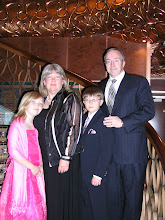
The Boyle Family at the Pyramids in Egypt and
Overlooking Jerusalem's Old City from Mt. Olive

We have safely sailed past the Somalia pirates and through the Suez Canal to the Mediterranean Sea. The past couple of weeks have found us exploring the sands and scents of Oman, scaling the incredible heights of ancient Egyptian temples, burrowing hunchback through one meter tall tunnels and tombs buried hundreds of feet below the Giza pyramids, and following the footsteps of Christ through the Jerusalem streets to the Holy Sepulcher church. Just the normal stuff we’ve been doing for the past three months. Okay, not exactly normal! It is hard to call anything about the Middle East “normal”, even things that seem to occur every day. To fully understand the Middle East would likely take many life times (perhaps that is why the ancient Egyptians believed in resurrection!), and our brief exposure has shown us just how little we know and how much we have to appreciate at home.
One of the surprising things for us in the Middle East is how close all of the cities are that we see so often in the news. We think of vast countries and territories when in fact they are only a few hundred kilometers apart. In about the same distance from it takes to go from Calgary to Edmonton, it is possible to draw a path that would touch parts of Egypt, Saudi Arabia, Syria, Lebanon, Iraq, Israel and Jordan! Not that anyone would want to leave Calgary for Edmonton during the Stanley Cup playoffs unless you would like to golf with the Oiler players in Edmonton, but hopefully you get the picture!







